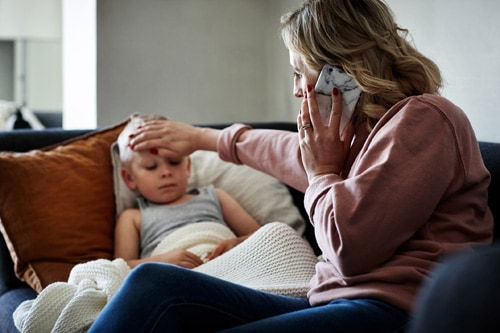Illness and Symptoms
You cannot get infected from drinking water contaminated with Naegleria. You can only be infected when contaminated water goes up into your nose.

Primary amebic meningoencephalitis (PAM) is a disease of the central nervous system. PAM is caused by Naegleria fowleri, a free-living ameba. It is a rare disease* that is almost always fatal; only 4 out of 157 people in the United States have survived infection from 1962 to 2022.
Signs and symptoms of Naegleria fowleri infection are similar to bacterial meningitis, which lowers the chances of diagnosing PAM at first.
People become infected when water containing Naegleria fowleri enters the nose and the ameba migrates to the brain along the olfactory nerve. People do not become infected from drinking contaminated water. Symptoms start 1 to 12 days (median 5 days) after swimming or having another nasal exposure to water containing Naegleria. People die 1 to 18 days (median 5 days) after symptoms begin. PAM is difficult to detect because the disease progresses rapidly so that diagnosis sometimes occurs after the patient dies. Signs and symptoms of the infection include:
- Severe frontal headache
- Fever
- Nausea
- Vomiting
- Stiff neck
- Seizures
- Altered mental status
- Hallucinations
- Coma
The disease is generally fatal; among well-documented cases, there are only five known survivors in North America: one from the United States in 1978, one from Mexico in 2003, two from the United States in 2013, and one from the United States in 2016. The first U.S. survivor’s condition gradually improved during a one-month hospitalization. The only reported side effect to treatment was a reduction in leg sensation for two months after discharge, which gradually improved. There was also no detection of Naegleria fowleri 3 days post-treatment. It has been suggested that the first survivor’s strain of Naegleria fowleri may have been less virulent, which contributed to the patient’s recovery. In laboratory experiments, a California survivor’s strain did not cause damage to cells as quickly as other strains, suggesting that it is less virulent than strains recovered from other fatal cases.
The Mexico survivor’s condition did not begin to improve until 40 hours after hospital admission. On day 22 of admission, there was no abnormality shown in the brain scan and the patient was discharged the next day. The patient was followed up for the next 12 months without any recurrence of disease.
After 35 years without a Naegleria survivor in the United States, during the summer of 2013, two children with Naegleria fowleri infection survived. The first, a 12-year-old girl, was diagnosed with PAM approximately 30 hours after becoming ill and was started on the recommended treatment within 36 hours. She also received the investigational drug miltefosine, and her brain swelling was aggressively managed with treatments that included therapeutic hypothermia (cooling the body below normal body temperature). This patient made a full neurologic recovery and returned to school. Her recovery has been attributed to early diagnosis and treatment and novel therapeutics including miltefosine and hypothermia.
The second, an 8-year-old child, is also considered a PAM survivor, although he has suffered what is likely permanent brain damage. He was also treated with miltefosine but was diagnosed and treated several days after his symptoms began. Therapeutic hypothermia was not used in this case.
In the summer of 2016, a 16-year-old boy was reported as the fourth U.S. PAM survivor. This patient was diagnosed within hours of presentation to the hospital and was treated with the same protocol used for the 12-year-old 2013 survivor. This patient also made a full neurologic recovery and returned to school.
Overall, the outlook for people who get this disease is poor, although early diagnosis and new treatments might increase the chances for survival.
- Marciano-Cabral F, Cabral G. The immune response to Naegleria fowleri amebae and pathogenesis of infection. FEMS Immunol Med Microbiol. 2007;51:243-59.
- Visvesvara GS. Free-living amebae as opportunistic agents of human disease. J Neuroparasitol. 2010;1.
- Yoder JS, Eddy BA, Visvesvara GS, Capewell L, Beach MJ. The epidemiology of primary amoebic meningoencephalitis in the USA, 1962-2008. Epidemiol Infect. 2010;138:968-75.
- Capewell LG, Harris AM, Yoder JS, Cope JR, Eddy BA, Roy SL, Visvesvara GS, Fox LM, Beach MJ. Diagnosis, clinical course, and treatment of primary amoebic meningoencephalitis in the United States, 1937–2013. J Pediatric Infect Dis Soc. 2014;Epub: 1–8.
- Seidel J, Harmatz P, Visvesvara GS, Cohen A, Edwards J, Turner J. Successful treatment of primary amebic meningoencephalitis. New Engl J Med. 1982;306:346-8.
- Vargas-Zepeda J, Gomez-Alcala AV, Vasquez-Morales JA, Licea-Amaya L, De Jonckheere JF, Lores-Villa F. Successful treatment of Naegleria PAM using IV amphotericin B, fluconazole, and rifampin. Arch Med Res. 2005;36:83-6.
- Linam WM, Ahmed M, Cope JR, Chu C, Visvesvara GS, da Silva AJ, Qvarnstrom Y, Green J. Successful treatment of an adolescent with Naegleria fowleri primary amebic meningoencephalitis. Pediatrics. 2015;135:e744-748.
- Cope JR, Conrad DA, Cohen N, Cotilla M, DaSilva A, Jackson J, Visvesvara GS. Use of the novel therapeutic agent miltefosine for the treatment of primary amebic meningoencephalitis: report of 1 fatal and 1 surviving case. Clin Infect Dis. 2016;62(6):774-6.
- John DT, John RA. Cytopathogenicity of Naegleria fowleri in mammalian cell cultures. Parasitol Res. 1989;76:20-5.
*Rare Disease
There is no universal definition of a “rare disease” but the U.S. Rare Disease Act of 2002 defined a rare disease as affecting less than 200,000 people in the U.S. and this definition has been adopted by the National Institutes of Health, Genetic and Rare Diseases Information Centers.